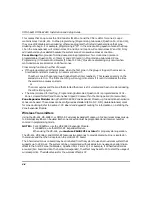
OMNI-624/OMNI-624EU Installation and Setup Guide
2-4
output capacity of the control panel includes the power available from these terminals (6 and 4) as
well as the power used by the keypads (23 [+] and 20 [–]) and smoke detectors (7 [–] and 6 [+]).
Therefore, to determine the total power available from these terminals, subtract the power
consumed by the keypads and smoke detectors. NOTE: For UL installations, total current cannot
exceed 180mA including the keypads connected to terminals 20 through 23.
ZONE INFORMATION (HARDWIRED ZONES):
8 (+) & 9 (–)
Zone 1 [Default = DELAY]
13 (+) & 12 (–)
Zone 4 [Default = INSTANT]
10 (+) & 9 (–)
Zone 2 [Default = INTERIOR]
14 (+) & 15 (–)
Zone 5 [Default = INSTANT]
11 (+) & 12 (–)
Zone 3 [Default = INSTANT]
16 (+) & 15 (–)
Zone 6 [Default = INSTANT]
Normally-closed devices may be wired in series; normally open devices may be wired in parallel. A
2.2k-ohm end-of-line resistor can be installed on all zones. (Refer to the wiring diagram.) The
standard loop response time is 280mS on all zones. The factory default values for each zone are
listed in the table above; however, any zone can be programmed for the following types: delay,
perimeter, interior, fire, 24-hr. alarm, or 24-hr. trouble. Further explanation of the zone types can
be found in the System Programming section of this manual. See the “Hardwired and Zone
Expansion Module” paragraph in Section 4: System Configurations for information on zone doubling
(to increase the number of available hardwire zones) and the use of double-balanced zones.
NOTE: Loop response is defined as the minimum time required for a fault to trip a zone.
RF RECEIVER — ZONE INFORMATION (WIRELESS ZONES):
Up to 24 wireless zones can be used if
the ZR-401, ZR-402EU, or OMNI-RF Wireless Expansion Module is installed. The maximum
number of zones (24) includes the 6 basic wired zones, wired zones using the expansion module, and
the wireless zones. Compatible ADEMCO 5800 Series or FBII ZR-500 Series wireless devices must
be used. See the “Wireless Zones” paragraph in Section 4: System Configuration for more
information on using wireless zones and for a list of compatible transmitters.
20 (BLK), 21 (YEL), 22 (GREEN) & 23 (RED) — KEYPADS:
Up to 12 keypads may be wired to these
terminals. The connections are as follows: 20 (BLACK = negative), 21 (YELLOW = data in), 22
(GREEN = data out) and 23 (RED = positive power). Refer to the table in the “Auxiliary Device
Current Draw Worksheet” paragraph of this section to obtain keypad current draw information.
NOTE: In some installations, it may be necessary to use shielded wire to prevent radio frequency
interference.
24 — EARTH GROUND:
Connect this grounding lug to a cold-water pipe utilizing 18AWG (1mm dia.)
wire at a distance of no greater than 15 feet (4.5m). Use a noncorrosive metal strap firmly secured
to the pipe to which the lead is electrically connected and secured. If the premises pipes terminate
in PVC, this terminal must be connected to a 6-foot (2m) grounding rod.
25 (BRN), 26 (GRAY), 27 (GREEN) & 28 (RED) — TELEPHONE LINE:
Connect the RJ31X cord as
follows: 25 (BROWN = Home Tip), 26 (GRAY = Home Ring), 27 (GREEN = Telco Tip), 28 (RED =
Telco Ring). Insert the plug into an USOCRJ31X Jack (or a CA31A Jack for Canadian installations).
The FCC registration number is 5GBUSA–44003–AL–E, and the ringer equivalence is 0.1B. The
system should not be connected to party lines or coin-operated phones.
If this control panel will be used for uploading, downloading, or remote-command applications, the
telephone line connected to the control panel must not be shared with a fax machine or modem.
Содержание OMNI-624
Страница 6: ...vi...
Страница 100: ...OMNI 624 OMNI 624EU Installation and Setup Guide 8 8...
Страница 102: ...OMNI 624 OMNI 624EU Installation and Setup Guide 9 2...



























